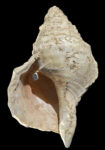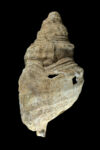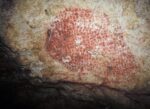 A prehistoric conch shell that was adapted into a musical instrument 18,000 years ago has been played again. Discovered in 1931 at the entrance to the Maroulas cave located in the foothills of the Pyrenees in southwestern France, it is the earliest known conch shell horn in the world and the only prehistoric one.
A prehistoric conch shell that was adapted into a musical instrument 18,000 years ago has been played again. Discovered in 1931 at the entrance to the Maroulas cave located in the foothills of the Pyrenees in southwestern France, it is the earliest known conch shell horn in the world and the only prehistoric one.
When it was first published in 1933, the Charonia lampas shell was believed to be a “loving cup,” a ceremonial drinking vessel. Its broken apex and outer lip were presumed to be natural damage, not the result of human intervention. Acclaimed at the time as an “exceptional discovery,” the shell entered the collection of the Natural History Museum of Toulouse and faded into obscurity until 2016 when researchers looked at it with fresh eyes and even fresher technology as part of a study of the cultural context of the Maroulas cave paintings.
 Analysis with modern imaging techniques found that the shell was in fact deliberately altered by the late Upper Palaeolithic Magdalenian people who occupied the cave. CT scans, photogrammetry and examination with a medical camera found considerable evidence of human transformation of the shell that enabled it to be blown. The apex of the shell, the toughest part of it, was broken off deliberately by being repeatedly struck. This could not have happened accidentally, by wave action when it was still in the ocean, say.
Analysis with modern imaging techniques found that the shell was in fact deliberately altered by the late Upper Palaeolithic Magdalenian people who occupied the cave. CT scans, photogrammetry and examination with a medical camera found considerable evidence of human transformation of the shell that enabled it to be blown. The apex of the shell, the toughest part of it, was broken off deliberately by being repeatedly struck. This could not have happened accidentally, by wave action when it was still in the ocean, say.
A hole running from the break in the apex into the interior of the shell is also man-made. It is extremely narrow with regular striations on its edge,  indicating that it was drilled. Researchers believe the apex was destroyed and the hole was created so a tubular mouthpiece, the hollow bird of a bone, for example, could be mounted to the shell. A residue of brown organic matter along the broken edge of the apex may be the remains of a resin or wax used to adhere the mouthpiece, something seen in less ancient examples of conch horns found in Syria and New Zealand. The labrum, the outer lip of the shell was also chipped off to make a finer, more regular edge.
indicating that it was drilled. Researchers believe the apex was destroyed and the hole was created so a tubular mouthpiece, the hollow bird of a bone, for example, could be mounted to the shell. A residue of brown organic matter along the broken edge of the apex may be the remains of a resin or wax used to adhere the mouthpiece, something seen in less ancient examples of conch horns found in Syria and New Zealand. The labrum, the outer lip of the shell was also chipped off to make a finer, more regular edge.
 Enhanced imaging further revealed faded remains of red ochre pigment dots on the columella (the inside of the wide opening) that are very similar to ones used to form a bison image on the wall of the cave. There are also very fine engravings under the pigment on the inner lip of the shell opening.
Enhanced imaging further revealed faded remains of red ochre pigment dots on the columella (the inside of the wide opening) that are very similar to ones used to form a bison image on the wall of the cave. There are also very fine engravings under the pigment on the inner lip of the shell opening.
The musical dimension of the conch shell from Marsoulas provides outstanding information on the symbolic activities linked to cave art. […]
We now have strong evidence that the Marsoulas shell comes from the archaeological level attributed to the beginning of the Magdalenian period. Its decoration with red pigments and graphic elements that exist on the walls of the cave supports this attribution. This is the first time that a symbolic link is attested between an ornate cave and a musical instrument. As with art, music is a production of social interactions. The strong link that must exist between image and sound certainly had a social function, which was to take its importance in social practices and rituals.
To test whether the shell was playable, the research team enlisted the aid of a musicologist and wind instrument specialist from the University of Toulouse. Jean-Michel Court played it by vibrating his lips as when playing a trumpet or trombone. Different notes depend on the tension of the lips and the amount of air blown into the cavity. Even with the sharp edges of the apex posing a grave risk of lip injury, Court was able to produce three distinct notes from the shell horn — C, D and C sharp.
Here they are:
It will be long time before they’re find all
In parts we did :boogie:
As far as the Rock ‘n Roll bits are concerned, not only the cavity of the instrument is important, but also the cave itself, i.e. sound-, vision- and otherwise.
Not to even mention the 5ex- and of course also the Drugs business that would have taken place in those caves.
If in the ‘Hohle Fels’ cave, for example, a bone flute from at least 35.000 years ago and e.g. the ‘Schelklingen phallus’ were found [silt stone, 19.2cm x 3.6cm x 2.8cm, 287gr.], why actually not a conch shell horn?
The show must go on!
Conch shell horns were common in the pre-Columbian Americas.
Play that funky Maroulas cave music, boogie-woogie bugle-boy!
Meanwhile in another cave:
https://www.youtube.com/watch?v=YXnb6QKNMPE
“bird of a bone”
The bird of a bone
when properly blown
emits a wonderful dulcet tone.
When the attachment’s done well
of bone-bird to shell
you avoid making the goose-honk from hell.
This is exciting. My cat reacted so fast to those sounds. She does not care about the music I listen to, but she was so alert when she heard this instrument.
I wonder if prehistoric people were using those shells for hunting or for playing with the animals. Maybe that way they found how to speak to cats? That would be fantastic to have such a cone. I would tell my cat to stop scratching the side of the door and my new drawing board. Going to find a shell on a beach tomorrow.
Of course Hollywood would have us believe that you played a conch shell by blowing in the other end of the shell.
Conch shells (Shankas or Chanks) are important ritual items even to this day in different parts of Asia. Historical accounts inform that for centuries, expert divers from among the sea-faring inhabitants of the Fishery Coast in Southeast India would dive deep in the waters of the Gulf of Mannar, fill their bags with large live marine mollusks, and triumphantly surface with their booty. Initially, itinerant merchants from Armenia, Persia and Arabia were their distinguished customers for chanks. Later, traders from Italy, Portugal, Flanders, Holland, France, Britain, and Denmark would regularly attend the chank sales at the end of the annual chank fishing expeditions. European traders would buy the commodity from the locals and carry it to their customers in Asia and beyond.
We now have strong evidence that the Marsoulas shell comes from the archaeological level attributed to the beginning of the Magdalenian period. Its decoration with red pigments and graphic elements that exist on the walls of the cave supports this attribution. This is the first time that a symbolic link is attested between an ornate cave and a musical instrument. As with art, music is a production of social interactions.
Melalui bantuan dari http://172.104.175.218/ kini anda dapat mengetahui informasi terbaru bet gratis yang sedang berlangsung di website judi slot online terpercaya yang berada di Indonesia. Karena saat ini hanya dengan melakukan visit website kami anda bisa memperoleh info freebet terbaru 2021 secara gratis melalui promo dan bonus betgratis terbaru situs judi online terbaik.